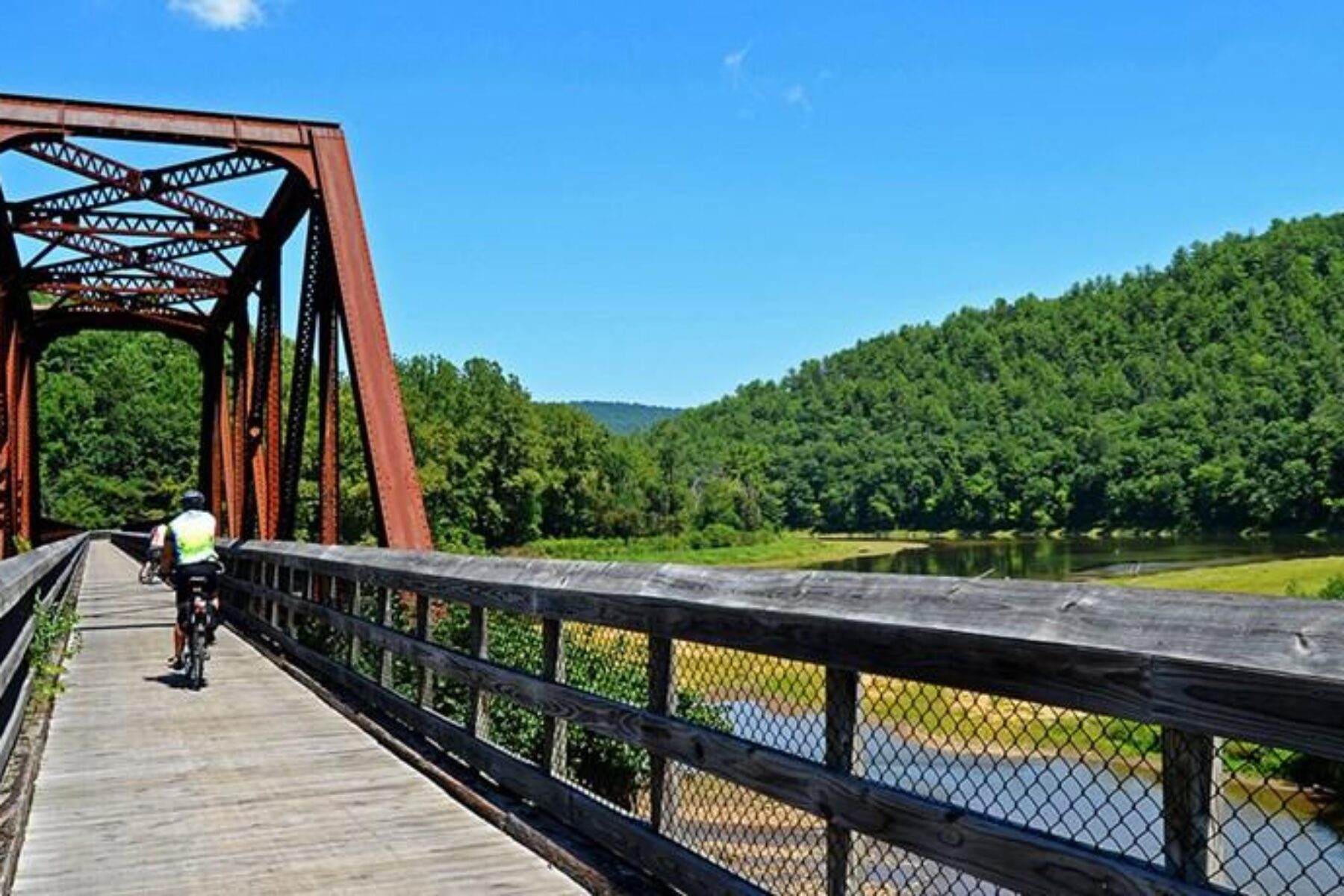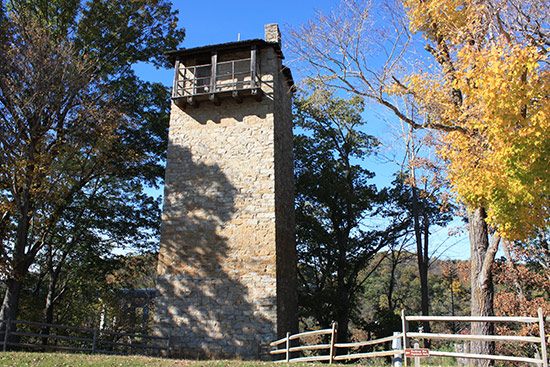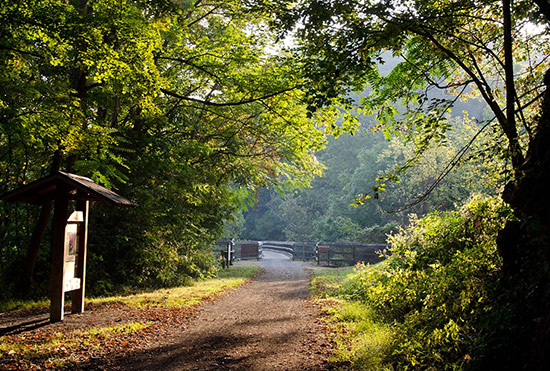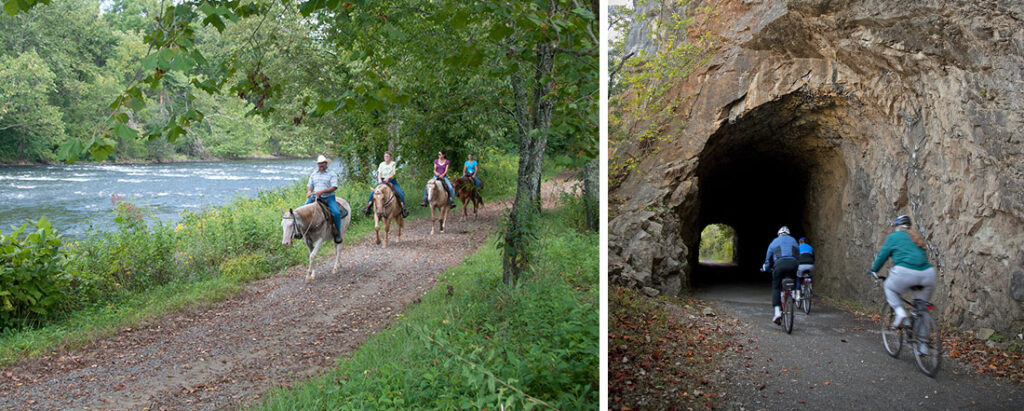Virginia’s New River Trail State Park

Trail of the Month: July 2015
“The feeling in the community is very positive and appreciative of the New River Trail. It draws tourism that greatly enhances our towns.”
Nestled in Virginia’s Blue Ridge Highlands, the New River Trail State Park offers 57 miles of green. With most of the trail running under a lush canopy of trees, and the presence of two invitingly dark tunnels, the low-grade, crushed-stone trail provides a pleasant summer ride. Its proximity to the New River, which is actually one of the world’s oldest rivers (geologically, speaking), also offers prime opportunities to cool off with canoe, kayak and tubing trips, or a simple dip in the water.

“The whole entire trail is beautiful,” says Anthony Akers, assistant county administrator for Pulaski County, one of four counties that the expansive trail traverses. “For the majority of the trail, you’re viewing the river; it’s one of its major draws. And a lot of the trail is shaded with high mountain walls on one side and steep slopes going down to the river on the other side.”
In addition to a boat launch and river access (including fishing), the park’s headquarters at Foster Falls—near the trail’s center point—offers guided horse rides, camping facilities and a shuttle service, making the trail a perfect springboard for a jam-packed family vacation. For those traveling with kids, restroom facilities about every 10 miles are a welcome sight, and the quaint downtowns of several small communities are accessible only a few miles off the trail.
When you live in the mountains, it’s hard to imagine living anywhere else … We’re big on preserving our greenspace and being able to enjoy it recreationally.
“When you live in the mountains, it’s hard to imagine living anywhere else,” says Akers. “We’re big on preserving our greenspace and being able to enjoy it recreationally. The feeling in the community is very positive and appreciative of the New River Trail. It draws tourism that greatly enhances our towns.”

The trail corridor, where once an industrial railroad ferried out locally mined iron ore, is now a haven for wildlife. “This past fall, a lady and her husband were out riding and saw a black bear about a mile down the trail, so they turned around and saw a turkey on the way back,” chuckles Sam Sweeney, a park manager with Virginia’s Department of Conservation and Recreation (DCR), which manages the rail-trail.
Remnants of this industrial past—like old iron furnaces, a tall shot tower where musket balls were made, restored train depots, railroad trestles and a bright red caboose at the southern trailhead in Galax—still dot the landscape that now feels serene and almost untouched. A smattering of trailside interpretive panels detail the area’s history, and more are planned.
The rail corridor was donated to the state by Norfolk Southern Corporation in 1986, and by summer 1987, the trail’s first four miles, from the Shot Tower historical site to Austinville, were opened. Other sections, which had bridges that needed re-decking and handrails, proved more challenging to complete; but, by the late 1990s, the full length of the trail was ready for the public. Today, amenities continue to be added to the trail to enhance the experience.

“We’re in the process of restoring an old orphanage that used to be a hotel when the railroad came through,” says Sweeney of a new project for revitalizing the late 19th-century Victorian-style building in Foster Falls. “We’ve restored the exterior and are hoping to obtain money in the next year or two to finish its interior. What was once the main hotel building will have a bed-and-breakfast set up, and the outlying buildings, like the ice house and boys dormitory, may be utilized for hostels.”
On the north end of the trail, more change is afoot; efforts are underway to transform a 241-acre site in Pulaski County where iron ore and iron oxides for pigments were once mined. Chuck Hoover, the president of Hoover Color, is an avid biker and wanted to put the property to good use by donating it to the state. The vision is to add 4 miles of mountain biking trail in its hilly terrain, which would be a pleasant contrast to the relative flatness of the New River Trail that runs adjacent.
“It looks like a western landscape,” says John Eustis, executive director of New River Land Trust, which is helping to facilitate the land exchange. “There’s a lot of texture to it and variation in color.” The minerals in the site’s rocky slopes—in rich shades of yellow, green and black—look striking and unexpected in this corner of Appalachia.

But one thing that does fit snuggly in place here is Draper Mercantile, a gleaming white-paneled building with a welcoming front porch, which exudes an easy, home-spun charm. Affectionately known as the Merc, the establishment is more than 100 years old.
“There were a lot of farms in Draper Valley,” says Gene Dalton, who manages The Junction bike shop inside the Merc. “And farmers came to the mercantile to buy supplies: sugar, flour and other groceries. Draper had a mill, a doctor’s office, a post office and a bank; it was a little town that served the valley.”
Nowadays, with its close proximity to Interstate 81 and the north end of the New River Trail (Dalton says, ‘Just look out the front door, and there it is’), Draper Mercantile is ideally situated and very popular. In addition to the bike shop, inside is a country-style store and restaurant. Amongst the goods for sale are historical treasures, like one of the site’s original potbellied stoves, which Dalton says people would gather around in the early days of television: “They’d come in and buy a soda and watch shows like ‘Amos ‘n’ Andy.’”
Each year, the park averages more than a million visitors and generates about $16 million in revenue for the surrounding communities.
That warm welcoming feeling seems to start here and roll down the trail. Dalton recalls a time when a small group of travelers who were visibly road weary popped in off the interstate for a bite to eat. Needing a stretch and nip of fresh air, they rented bikes on the spot and later returned from a trip down the New River Trail recharged and glowing. Their experience is not unique. Each year, the park averages more than a million visitors and generates about $16 million in revenue for the surrounding communities.

“Increasingly, this region of Virginia is realizing that we have an opportunity when it comes to eco-tourism,” says Eustis. “The New River Trail is a perfect example of that. A wide variety of businesses have been established because of it, and amenities like this can be real economic drivers for the local economy. No one is going to want to walk or bike a trail if they’re just going to see houses or factories or Walmarts. They want to experience beautiful rural landscapes like ours.”

Donate
Everyone deserves access to safe ways to walk, bike, and be active outdoors.
